Immersion Education, Ethnicity, and Income: Immersion Students in Urban Districts
The ACIE Newsletter, November 2008, Vol. 12, No. 1
Doreen Krueger, Professor of German and Teacher Education, Concordia University Wisconsin, Mequon, WI
This research study, which was conducted during 2000 and 2001, examines language immersion in an urban setting. This urban context adds issues of varied ethnic backgrounds, varied socio-economic levels and potentially more diversity in learning styles and learning challenges. Granville, the first immersion program in this Midwestern city, was the school site for the research. Its early immersion program has 4K through grade 5 and a continuation immersion program at a nearby school includes grades 6 through 12. The study posed a number of questions which were addressed by both qualitative and quantitative methods. Classrooms were observed, surveys distributed to students in three different grade level categories, grades 5, 8-10, 9-12, and post high school, individual interview sessions were conducted with a representative sample of surveyed students, and finally, standardized test scores were analyzed. One of the study’s focal questions explored the impact of the language immersion schooling experience on African American students and students from economically disadvantaged backgrounds.
While Canadian immersion programs have been found to exist in largely middle class schools, the schools in this study included a far more diverse student body. At the time of this study, there were 590 4K-5 students, 36.1% of which were identified as ethnic minority students, a decline from 43.4% five years earlier. Of that group, 1% was identified as either Hispanic or Native-American, and the remainder was African-American. Twenty-five percent of children qualified for free or reduced lunch, down from 29% the previous year. In the district as a whole, 61.2% were African-American, 14.2% were Hispanic, and 4.2% were Asian. Eighty percent of students qualified for free or reduced lunch.
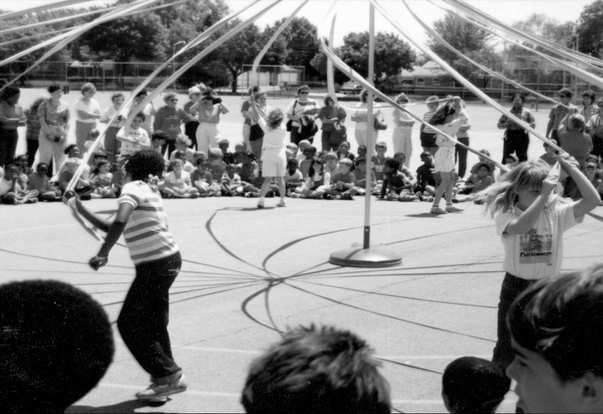
The Maibaum is part of a traditional celebration held at the time of the school’s annual Kinderfest.
Comparison of Third Grade Reading Test Results
Students in the early total immersion program are taught to read first in the immersion language, in this case, German. English reading is introduced in the second grade for the equivalent of thirty minutes each day. It is therefore expected and confirmed by most research that some lag in English reading skill will be evident for a year or two, until the reading skills in English can be brought up to grade level (Holobow, Genesee, Lambert, Gastright, & Met, 1987; Swain, 1990). German immersion students are tested, however, in grade 3 in English reading as are all students in the district. Tables 1-2 and Graph 1 compare grade 3 reading score means over eleven consecutive years (1988-1989 – 1999-2000) for the immersion school and the school district as a whole based on the district’s required standardized assessment, Wisconsin Reading Comprehension Test (WCRT) for Grade 3.
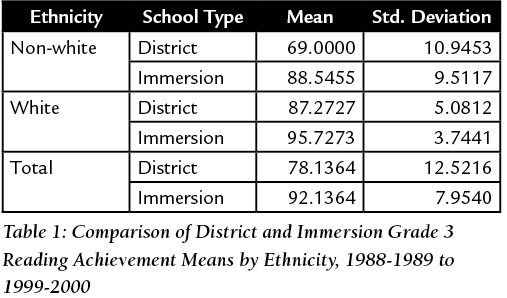
Using descriptive statistics, Table 1 shows that when mean scores are averaged across eleven years, German immersion students in Gr. 3 consistently outperformed district peers in reading, regardless of ethnic background.
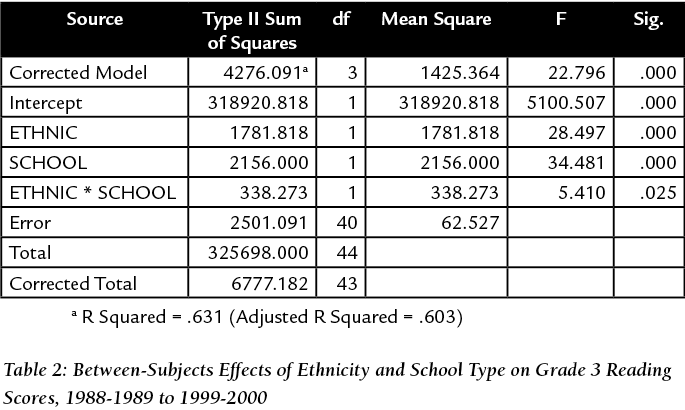
Table 2 displays statistical output from a 2x2 factorial ANOVA (Analysis of Variance) designed to measure the effect of two independent variables (ethnicity and school) on a dependent variable (reading score). Test results indicate a significant main effect for school and ethnicity. In other words, students from the German immersion school performed significantly higher than students who attended district schools (mean score of 92 as compared to 78) on reading scores with F(1,40)=34.48, p<.001. (A p-value of <.001 indicates a less than a 1 in 1000 chance that the differences observed were due to chance or error.) In addition, White students scored significantly higher than Non-White students1 (mean scores of 91 and 79) on reading scores (F(1,40)=28.5, p<.001). Finally, in Graph 1 results show a significant interaction between school type and ethnicity (F(1,40)=5.41, p<.025). (A p-value of <.025 indicates a less than 2.5 in 100 chance that the differences observed were due to chance or error.) This finding may suggest that in the immersion program a student’s ethnic background is not as big a factor in determining reading performance as that found in district schools as a whole. That is to say, participation in the German immersion school seemed to narrow the oft-seen gap between White and Non-White students.
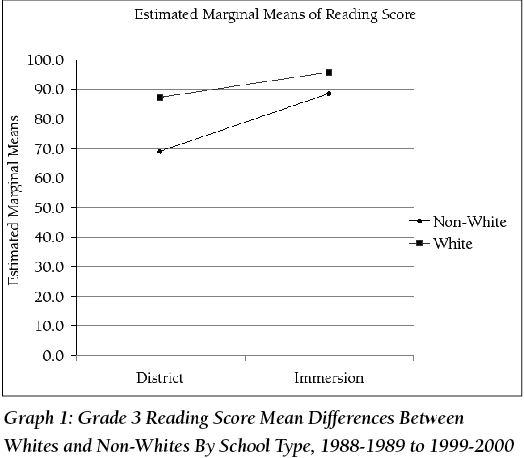
In sum, early total foreign language immersion did not appear to have a negative effect on the reading achievement of White or Non-White students. Both student groups outperformed district averages. Furthermore, the reading performance gap between.White and Non-White students was smaller for immersion students relative to district performance as a whole.
Comparison of Standardized Math Scores
Because a substantial number of students in my surveys and interviews questioned the negative impact that immersion may have had on their math ability, I compared the standardized test results for math over three school years. Math is almost exclusively taught in the target language, since program designers hypothesize that math content is less language-dependent, and therefore, lends itself well to instruction in a new language.
Table 3 shows the percentage of Gr. 4 students at or above the state standard for mathematics based on test data collected for the District Report Card during the 1997/98, 1998/99, and 1999/2000 school years. Economically disadvantaged children are identified as those who qualified for free or reduced lunch. Only twenty schools out of the 144 elementary schools in the district had 70% or more of their students perform at or above the proficient level in the 1999/2000 school year, and four of those schools had 90% of students at that level. Among the four was the German immersion school. In each year, a higher percentage of African-American students scored at the proficient level at the German immersion school when compared to either the district or state percentages. This was also the case for White students except for the 1998-1999 year, in which they scored five percentage points below the state level. For economically disadvantaged students, the students from the immersion school scored better overall than the same group at the district or state level. For the non-economically disadvantaged students, there were also higher scores, but for the 1998-1999 school year, that group had the same percentage of proficient level scores as students at the state level. These test scores seem to indicate that there is no inherent disadvantage to learning math in the immersion language. Only a few students out of the many who returned initial surveys mentioned weak math skills as a disadvantage of immersion. The following is a comment from one such interview:
I was never strong in math and it was harder for me to learn in German. And then um, but it was only because I had weaker math skills anyway, and I still do to this day. And it did make it a little more difficult for me to turn around… see, I don’t blame the language on it at all, I do have weak skills and I mean somebody with stronger skills probably wouldn’t have had a problem with it at all. (Sarah, age 25, White).
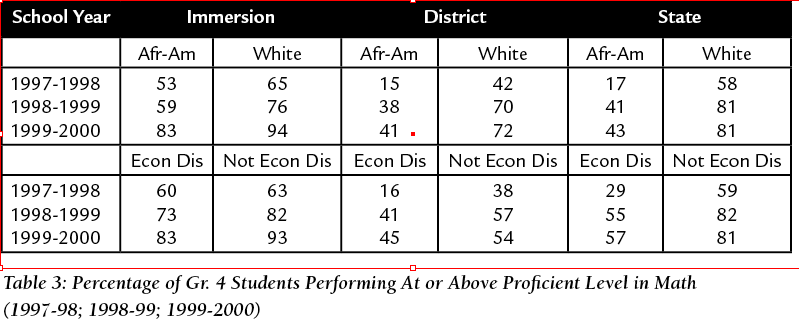
Comparison of Standardized Language Arts Scores
Because some students felt that foreign language immersion must have had a negative impact on their English language ability, I decided to examine the results of the state’s standardized tests for English language arts over the same three years. The following table also compares percentages of students at or above the state proficiency standard at school, district and state levels, disaggregated by ethnicity and socio-economic status.
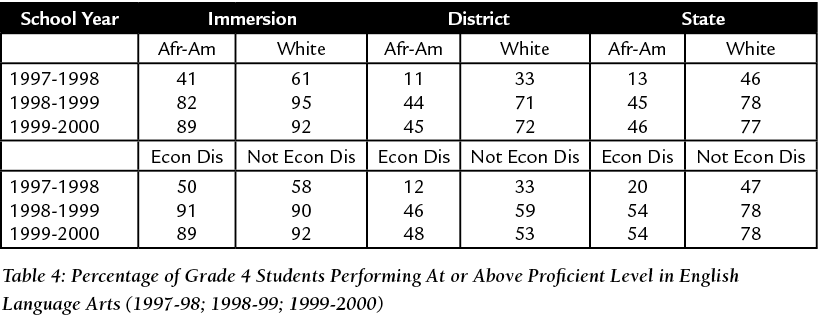
Table 4 reveals the percentage of fourth graders at or above the state standard for English language arts based on test data also collected for the District Report Card during the 1997/98, 1998/99, and 1999/2000 school years. The scores from the District Report Card showed that a consistently higher percentage of students at the immersion school scored at or above proficient in all three years relative to the percentages of students in the same ethnic and socio-economic categories at the state and district levels. It seems that the African-American students scored considerably higher, between 33 and 44 percentage points higher in 1998-1999 and 1999-2000. Students who were classified as economically disadvantaged also performed much better than students from the same category at the district and state levels. According to these standardized tests, students from the German immersion program do not seem to be at any disadvantage in the area of English language arts. Because of research findings in the Canadian French immersion program, students and parents in U.S. immersion programs are often cautioned that there may be a short-term delay in English language and reading skills because of the introduction of reading in the new language first. The lag seems to be very short in this case, based on these grade 3 reading scores, but the expectation persists. Here is the reflection of one student:
I learned how to read German before I could read English and that kind of messed a lot of us up because we didn’t start reading right —regular books and stuff, until we got into the second grade. But it really didn’t mess us up that much because the kids in our school who started reading in a foreign language first are the ones who are doing great in English now. I read on a 10th grade reading level and I’m in eighth grade. It held me back in the second, third and fourth grade. In the fifth grade I caught back up because I started reading books, and reading, and reading, and reading, and that kind of helped me. (Mariah, age 14, African American)
General Reflections
One interesting finding of my study was the nature of the reflections of students on their immersion experience, particularly students at the high school level and beyond. Most students described a valuable, unique experience which adds to the value of immersion for a diverse student population. The following excerpts from interviews provide examples:
That’s the biggest advantage for me. It wasn’t even the learning of German or the immersion program. It was being in that school. That school was way better than my alternative to go to. That’s how I gauge it; I’m up on everybody else cuz I didn’t have to deal with all that. Drug problems, fighting, violence, and teachers too. Teacher quality, one-on-one with the teacher, more time with the teacher. They take their time a lot more with the immersion kids. (James, age 25, African American)
They had really high standards. I think because of the whole experience being a little different, it made me feel special, that I was privileged or something. Like I thought I had some sort of focus when I was younger. A lot of kids don’t have that. (Robert, age 26, White)
While early immersion students’ test performance seems to indicate that such a schooling experience is appropriate for a diverse range of children, one student shared his doubt based on his family’s experience.
My little sister was in the school but she was having trouble so my mom took her out. She was in first grade last year. My mom worked with all of us, like with homework…and when she worked with my sister, my sister was struggling and she’d get really frustrated because she wasn’t getting good grades. She wasn’t used to that because my brother and I didn’t have those problems and she started feeling like she kind of forced it on her and it made it worse because she didn’t have a good attitude about it and my mom decided to let her change schools and now her grades are a lot better. I think if you’re struggling…and if they can’t find out what the problem is…. Everyone’s not cut out for the same thing. (Michael, age 20, African American)
Conclusion
The students most often expressed their feelings of belonging to a privileged group, a unique learning community. Some said it was a wonderful topic to bring up in a job interview since it usually captivated the interviewer’s attention. The eighteen interviewees between the ages of 10 and 25 spoke with fondness about their experience in the German immersion program. They shared their specific memories, many of which had something to do with the rich cultural experiences offered by the school. They also expressed appreciation for the unique schooling opportunity and valued their acquisition of a second language.
Speaking to all the old neighbors from around the neighborhood who had fled Germany. I remember they all praised me and said they couldn’t believe first of all that a kid that small from America could speak German that well. Second of all, they were really amazed that a Black kid that small could speak German that well. That just blew their minds. (James, age 25, African American)
The immersion experience served to unite the diverse student body with their unique experience. They had high levels of confidence in their ability to appreciate both language and culture. In some sense they realized that they were part of a special cultural and linguistic experience, which in turn made them special. Sarah expressed an important aspect of this specialness and at the same time offered a compelling rationale for making the program available to children of all groups.
Why would you have anything against another culture, if you’ve been learning a different language and a whole different culture your whole life? You’re not going to have something against another language just because it’s not the same as the second one you learned. We had curiosity even to learn about other cultures and languages as well. (Sarah, age 25, White)
Endnotes
The term “Non-White” is used in reporting these data, because there was one Hispanic child in that group and separating the scores by ethnic group jeopardizes the privacy of that student.
